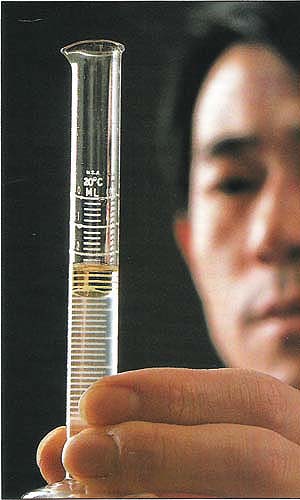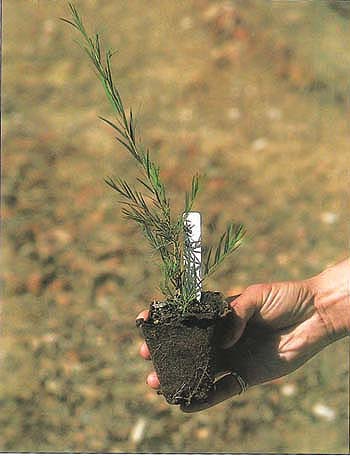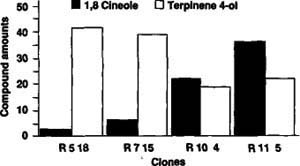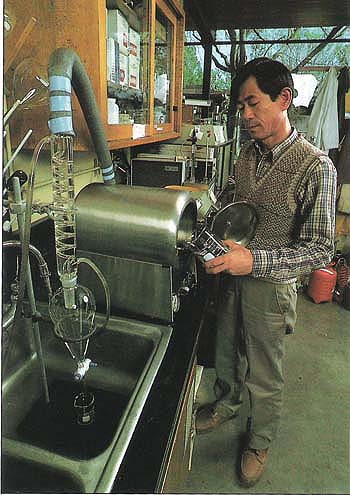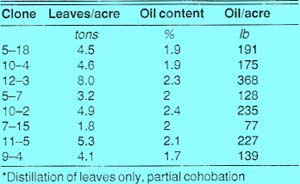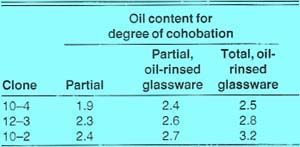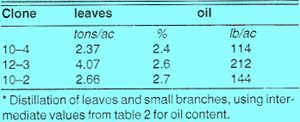All Issues
: new crop for California?
Publication Information
California Agriculture 44(4):27-29.
Published July 01, 1990
PDF | Citation | Permissions
Abstract
Researchers say tea trees can we grown successfully and with profitable oil yields in California's Central Valley. Based on an analysis of seedlings from one seed source, the yield from a seedling plantation would be about half that of a clonal plantation derived from the best seedlings.
Full text
Foliage of Melaleuca alternifolia [Cheel], a woody perennial commonly known as the tea tree and native to northern New South Wales, Australia, contains approximately 1 to 2% (by fresh weight) essential oil. This oil, because of its demonstrated antibacterial and antifungal activity, has commercial value in the treatment of skin lesions and is used in the manufacture of shampoos and other health-related products. The market for tea tree oil in the United States is increasing, and demand currently exceeds supply. Prices for the oil imported from Australia exceed $10 per pound. Research on the agronomic and horticultural characteristics of the crop was considered an essential preliminary step to determining its economic potential in California.
Plant materials.
We sowed seeds of M. alternifolia densely in rows spaced 1 cm apart in a flat of a fine-grained sand. The surface was kept moist by misting at 2.5-minute intervals during daylight hours. Flats were maintained at 75°F. The germination rates of three seed lots were between 10 and 20% over several weeks. Emergence in the flats occurred at 2 weeks. About 6 weeks after emergence, the most vigorous seedlings were transplanted to peat pots in a peat-sand mixture, which were then maintained in a greenhouse at 75°F during the day and 65°F during the night for another 5 to 6 weeks. Plants were then moved to a lath house for a week of hardening before field planting.
Plantation establishment and performance.
Using about 250 of the most vigorous seedlings, we established a 0.2-acre plantation, with plants spaced on 2.5-to 3-foot centers under drip irrigation (one emitter per seedling) in April 1986 at UC Davis. One hundred pounds of elemental nitrogen was applied as ammonium sulfate in the spring of the second year of cultivation. We observed considerable variation in the vigor of seedlings within a few months of planting, and many seedlings became chlorotic. The plantation canopy closed sometime during April 1987. The most vigorous seedlings were 9 to 10 feet tall with stem diameters of up to 1 1/2 or 2 inches' diameter 18 inches from the ground.
Tea tree oil floats on water in this graduated test tube. The antibacterial and antifungal properties of this oil make the tea tree a valuable crop for medical and hygene applications.
After initial rooting, establishment in the greenhouse, and hardening in the lathhouse, a tea tree clone is ready to be planted in the field. Twice-a-year harvesting of the 12-3 clone planted at 5,000 trees per acre could yield 368 pounds of oil.
Plant sampling and yield determination.
At 12 to 14 months after planting, individual seedlings were cut approximately 18 inches from the ground, and branches with leaves were stripped from the main stem. The stem was weighed and discarded. The branches were weighed, and 0.2-pound samples were taken for steam distillation.
Propagating potential high-yield seedlings.
We made 10 cm stem cuttings from lateral branches of the eight seedlings with the highest oil percentage (table 1). After dipping the bases for 10 seconds in a 4,000 mg per liter indole butyric acid solution, we stuck them into a 50:50 perlite-ver-miculite mix in flats. The flats were placed under mist benches with bottom heat (the same as for seed germination) for 2 to 3 weeks, after which time most cuttings had begun root initiation. Rooting percentage exceeded 70% for all seedlings tested from April to July. Rooted cuttings were transplanted to peat pots in a peat-sand potting mix, maintained in a greenhouse for one to two weeks, and then moved into a lathhouse for hardening before field planting. Clones were field planted on 3-foot centers (about 5,000 plants per acre) in 28 to 35 plant blocks, and each block had double borders. Yields of foliage with small branches were determined for three clones as described above.
Fig. 1. Ratios of terpinene-4-ol to ceneole for oils from four clones analyzed by gas chromatography. All samples were taken in fall, 1988.
Steam distillation.
The steam distillation apparatus consisted of a sterilizer with a separate compartment constructed to contain the plant tissue sample and a steam outlet that led directly to a condenser and collection funnel. Distillate was collected for up to 2 hours in a 500 ml separatory funnel.
Cohobation is the practice of recycling the aqueous distillate back into the steam chamber. Since our still was not fitted to permit automatic recycling of the aqueous fraction, we had to distill two plant samples when we wanted to practice cohobation. Most of the lower aqueous fraction was discarded unless cohobation was practiced.
The aqueous fraction collected from the first distillation, usually in excess of 500 ml, was used as the charge for distilling the second sample. The bulk of the aqueous fraction collected from the second distillation was discarded, and the remainder was collected in a tared, 15 ml graduated test tube. The volume of the oil layer suspended on top of the aqueous layer was recorded, along with that of the remaining water layer. The tube and contents were weighed. The oil weight was determined by subtracting the new tare weight (which included the small aqueous fraction) from the total tube weight. We calculated the specific gravity of the oil from the weight and volume data. The following equation gives the percentage oil in the sampled plant tissue:
% oil=(oil weight/fresh weight plant sample) × 100
Leaves and small branches analyzed were about 35% dry weight, so the oil percentage on a dry-weight basis could be computed by dividing by 0.35.
Gross oil yield.
Biomass accumulation, oil content, and oil yield varied widely among seedlings. Data on leaf and stem biomass and percentage oil for the top eight seedlings of the more than 200 analyzed are ranked by oil content in table 1. The specific gravity of the oil isolated was between 0.89 and 0.91 for all seedlings.
Initially, we performed all distillations without cohobation, with washed glassware. Some values for oil content were 50% lower than when we employed cohobation and pre-rinsed the glassware with oil. Five samples were distilled for each selected clone to determine the oil yield as a function of each of three distillation techniques: (1) no cohobation, (2) total cohobation with oil-coated glassware, and (3) total cohobation with oil-coated condenser glassware.
Small stems were included in distillations designed to simulate a commercial harvest; the plants sampled were shrubs, not trees. We ran replicate distillations for some clones, but the distillations in table 2 were not replicated sufficiently for statistical analysis. Variance was on the order of 5% (change of 0.1% in oil content) for repeat distillations. Cohobated distillations yielded significantly more oil, and further increases became apparent when all of the glassware used was pre-rinsed with oil from prior distillations. Note that cohobation is of critical importance for the qualitative analysis of tea tree oil because of the extreme water-solubility of terpinene-4-ol, the most vital ingredient in tea tree oil.
Although there is danger in extrapolating commercial yields from small test plots, the projected annual yields for clonal plantations derived from the top eight seedlings, with about 5,000 plants per acre (assuming growth rates equivalent to that of the test seedling), suggest that some clones of this species would be outstanding candidates for commercial exploitation. These clones have relatively high foliage yield and oil percentage, resulting in a high per-acre oil yield. However, qualitative analyses suggest that only two clones produce oil that would meet current world standards for tea trees. The Australian specifications for tea tree oil are 1-8 cineole not greater than 15% and terpinene-4-ol not less than 30%.
Gas chromatographic analysis of oils.
A temperature programmable gas chromatograph fitted with a megabore capillary column and a flame ionization detector and integrator was used to analyze all distillates. The analyses indicate that two of the eight high oil clones, 5-18 and 7-15, produce an oil with approximately 40% terpinene-4-ol and less than 10% cineole (fig. 1).
Soil pH.
Many field-grown seedlings were highly chlorotic and grew poorly. All of the field-planted materials were of a lighter green than greenhouse-grown seedlings and clones. The two field plantations were grown in soils of pH 7.3 to 7.8. The peat-sand soil mix for greenhouse plants had a pH between 6.5 and 7 over three months of observation. Foliar applications of ferrous sulfate to field-grown plants resulted in somewhat darker green foliage, although we observed no substantial difference in plant growth. Growth of seedlings in solution culture was severely inhibited at pH 8, but vigorous at pH 6 to 7.
Future research
Planting density.
Relatively high-density plantations of 3x3 feet are recommended. This spacing permits approximately 5,000 plants per acre, and should prove sufficient to give canopy cover in 12 to 18 months. At higher densities, expect faster cover, smaller plants (which may prove more satisfactory for optimum foliage yield), and increased early yields. An economic analysis that includes the costs of plant materials and field planting, and the expected increase in yields for the first year or two as a function of planting density, must be used to determine the optimum density.
Harvest times and frequencies.
With growth rates equivalent to those obtained following a March-April field establishment, first harvests could begin 3 to 5 months after planting, when the plants are about 3 feet tall. The first cut should be made 1 foot above ground level to encourage branching from the crown. All harvesting protocols should promote branching and small stem diameters, since oil yield is negligible in large-diameter stems and is highest in the foliage. Harvests could be repeated as soon as the new shoots added about 3 feet of growth. Frequent harvesting is likely to keep many herbaceous shoots on the plants; hence, an alfalfa or silage mower may prove suitable for initial harvest trials.
TABLE 1. Oil contents and estimated annual yields per acre of 8 most productive clones, 1986-87 crop*
TABLE 2. Oil content (fresh weight basis) of leaves and small branches with cohobation and oil-rinsed glassware, selected clones from 1988-89 crop
TABLE 3. Oil content and estimated per-acre oil yields for 3 clones from table 2 (estimates are from the 1988-89 crop damaged in the February 1989 freeze; test blocks planted at 4,800 trees/acre)*.
Soil, water quality, and climate.
Small plantations of Melaleuca alternifolia seedlings and clones should be established at several locations in California for studies on yield and quality as functions of site and climate. The clones were damaged during the hard freezes at Davis in February 1989, and this accounts for somewhat lower yields in 1989 than in 1987. Mild winter temperatures appear to be important. Seasonal variations in oil quality and yield should be examined. The plants at Davis produced more oil in late summer than in early spring, a possible indication of the importance of high summer temperatures or low atmospheric humidity. Water quality, particularly pH, is significant.
Genotypic variation.
Additional seedling blocks will help us examine further seedling variations in vigor, oil quality, and yield, as well as adaptation to high pH. Our initial screening of 250 seedlings for vigor and oil yield suggest that further research could lead to (1) better-yielding clones, perhaps with higher-grade oil, and (2) a more accurate picture of the genetic determinants of yield and oil content. More rapid distillation and gas chromatographic techniques for seedling analyses would facilitate such a study.
Economics.
At $10 per pound of oil wholesale, projected annual farm gate values for the oil derived from clones yielding about 5 tons of foliage per acre per year exceed $1,800 per acre. Cultural costs are estimated at $600 per acre for the first year, and approximately $200 to $300 per acre (depending on irrigation and harvest costs) throughout the life of the plantation. Distillation costs are estimated at $40 per ton of biomass processed, or about $200 per acre. Plant materials would cost about $2,500 for an acre of clonal plantation and about $1,000 for an acre of seedling plantation; both are one-time costs. Plantation longevity is unknown, but may exceed 25 years. Some Australian plantations have been harvested for longer than that. Positive cash flow would be expected in the second or third year of cultivation.



